Egypt ~2600BC-1087BC
Contemporary Events
- The Old Kingdom: 2620-2280BC. Pyramid building is in full force.
- The Middle Kingdom: 2134-1786BC
- The New Kindom: 1575-1087BC. Tutankhamen, Hatshepsut, and Nefertiti all lived during this era.
- 670BC Assyria conquers Egypt, but their reign is short lived
- 525BC Persians take over the area.
- 332BC Alexander the Great, a Greek conquers Egypt.
- Cleopatra died in 30BC.
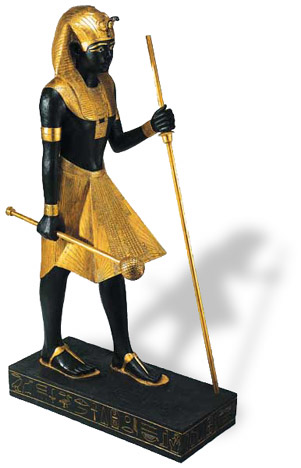
Egyptian Guardian 4Ft. Statue from King Tut’s Tomb
Egyptian Guardian 4Ft. Statue It was found in the Antechamber, during the excavation of King Tut’s Tomb in 1922 by the Earl of Carnarvon and Howard Carter.
The Egyptians
This gilded wooden statue of Tutankhamun depicts the pharaoh wearing the following items:
- A headdress: possibly a cloth Nemes Headdress with a uraeus (cobra) on the front. The uraeus is a symbol of nobility and is a common addition to any of the various royal headdresses.
- A wide collar that is most likely created through intricate beading. These collars, generally, were not solid pieces of metal as they appear.
- A pectoral: a large amulet or pendant necklace that generally carried religious significance.
- Armbands, wristbands
- A schenti: a wrapped linen skirt. It is possibly pleated. There is likely a loincloth underneath his schenti.
- An apron: this is depicted with a large triangle. They could be heavily decorated with jewels, and were most likely ceremonial rather than functional. There is much debate over whether the apron is merely an extension of the schenti or a separate garment.
- Sandals: possibly made of papyrus or rushes (reed-like plants) and gold.
In the image at the right, we see various gods (Hathor and Anubis) and a pharaoh (Tuthmosis IV) in
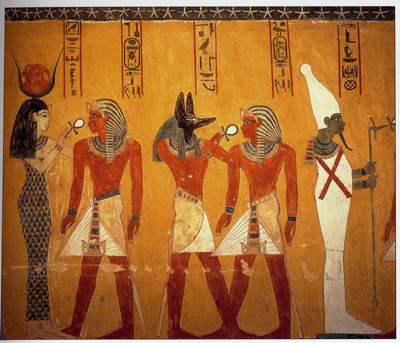
Found in the tomb of Tuthmosis IV. The scene depicts the pharaoh’s passage into the afterlife.
typical Egyptian dress. The males wear attire similar to the King Tut image above.
Hathor (the woman on the left) is wearing a Bead-net dress (it is likely worn over a Sheath dress). It appears to be created though intricate beading.
Tuthmosis IV (the pharaoh whose image is repeated) wears the Nemes Headdress. This was a striped cloth headdress often associated with King Tut.
The figure at the far right (representing a previously deceased pharaoh) is wearing the Atef Crown. In this depiction the previously deceased pharaoh has been mummified.
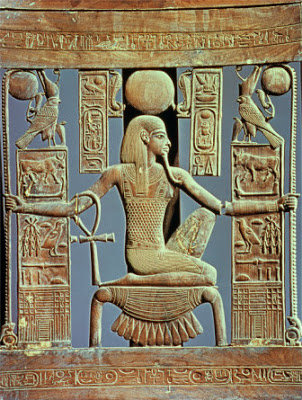
Carving from the back of a chair discovered within the tomb of Tutenkhamun is a depiction of the Spirit of the Million years, named Heh, (circa 1370-52 BC).
This image from the back of one of Tutankhamun’s thrones depicts the god Heh. He wears a postiche (a false beard symbolic of the ruling pharaoh). When deities are depicted wearing postiches, they are usually curved as the one shown here. Those worn by the pharaoh were straight. Heh also wears a corselet (a form of armor believed to have been created from overlapping pieces of leather or metal). He wears other garments typical of Egyptian attire that have been mentioned in the examples above.
These women show many of the forms of attire available for women.
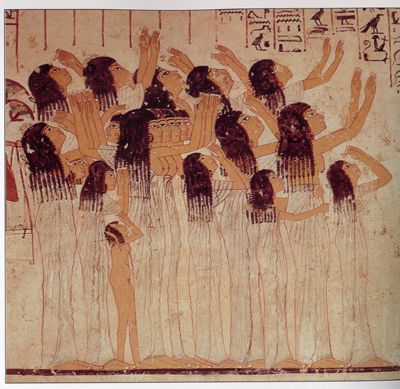
Mourners at the tomb of Re-Mose, who was a Vizier under Amenophis III.
Some are bare breasted with either one or both breasts exposed. Other women wear the calasiris (a wrapped dress-like garment which usually features a cape-like sleeve over one or both shoulders). The naked figure likely is a slave rather than a child. Slaves were often depicted as smaller as a symbol of their lower status.
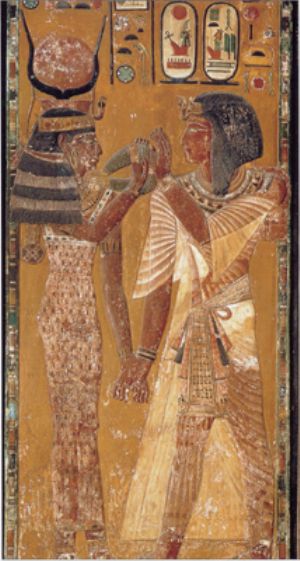
Hathor welcomes Seti I to the afterlife.
This image features the goddess Hathor welcoming the pharaoh Seti I into the afterlife. She wears similar garments as the previous image of her featured here. Seti I wears some interesting variations on typical Egyptian garments. They are unusual due to their sheer quality, though it is believed that fine, sheer linens did exist. This image allows us to see all the layers as they would have been worn due to the sheer qualiy. Starting with the layer closest to the skin the following items are depicted:
- loincloth
- schenti (look to the hem, it is shorter than the calasiris).
- apron (though not triangular here, it is heavily decorated)
- calasiris
- wide collar
- crown or wig with a fillet/diadem.
- uraeus at the front of his headdress/wig
- armbands
- sandals
- kohl lining his eyes.
Some examples of Egyptian Crowns and Headdress beyond what we have discussed in class can be found in the following images:
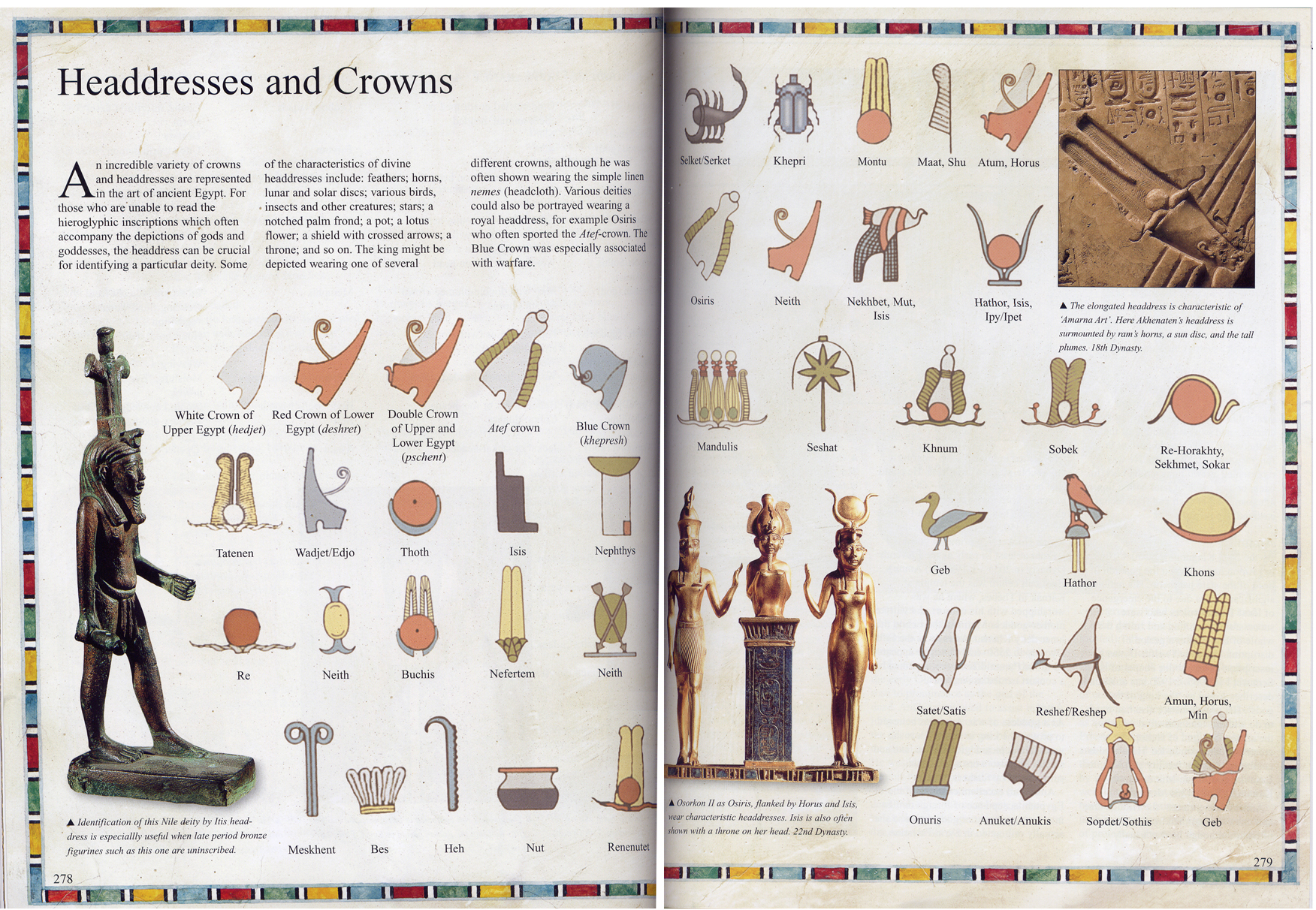
QUICK REVIEW
TYPE OF DRESS: draped
TEXTILES: primarily linen
SILHOUETTE SHAPE: Tall & Narrow with an unnatural emphasis on the head. Natural hourglass is visible.
BASIC GARMENTS: Loincloth, wrapped skirts (schenti), aprons, wrapped dresses (calasiris), sheath dress, sandals, headdress/wig,
MOTIVATIONS FOR DRESS: Status and decoration
KEY IDENTIFIERS: lots of gold, huge headdresses among leaders and deities, white/cream garments, make-up use (heavily lined eyes, especially).
Recent Comments